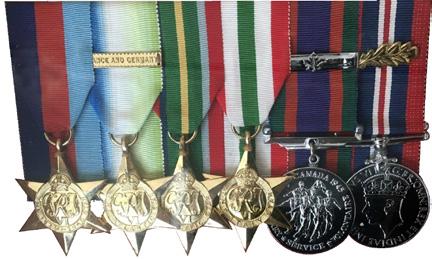
1 minute read
Operation Neptune: The RCN in support of D-Day
Lookout for HEROES
June 6 was the 79th anniversary of the most incredible amphibious operation in history. Operation Overlord was the Allied invasion of Normandy that led to the liberation of Western Europe from the brutal fouryear occupation of Adolf Hitler’s Nazi Third Reich.
Advertisement

General Dwight D. Eisenhower, Supreme Commander of the Allied Expeditionary Force, issued his order of the day 79 years ago.
“Soldiers, Sailors, and Airmen of the Allied Expeditionary Force,” the order stated, “you are about to embark upon the Great Crusade, toward which we have striven these many months. The eyes of the world are upon you. The hopes and prayers of libertyloving people everywhere march with you.”
But, before any of the 132,000 allied soldiers – including over 14,000 Canadians – landed on the Normandy beaches, Operation Neptune involved almost 7,000 allied vessels and ensured that battles were fought and won and critical operations conducted in a supporting naval effort behind the D-Day landings.
The Royal Canadian Navy (RCN) was essential in that effort.
Between 1939 and 1944, allied sea power first secured the Atlantic shipping routes transporting troops, supplies, and equipment during the hard-fought Battle of the Atlantic. Then, allied navies concentrated against the enemy surface and submarine forces in the English Channel and along the coast of France that threatened the D-Day landings. Canadian destroy- ers and motor gun/torpedo boats fought many closequarter actions and helped secure the sea approaches to Northern France for the Allies but at the loss of HMCS Athabaskan. RCN minesweepers cleared approach lanes through the 120-mile barrier of sea mines off Normandy right up to the invasion beaches. These minesweepers were part of the 109 Canadian warships, with 10,000 RCN, Royal Canadian Naval Reserve and Royal Canadian Naval Volunteer Reserve (RCNVR) members. In the final assault on Hitler’s Festung Europa (Fortress Europe), these Canadian units landed the troops, tanks and equipment on Juno and Gold beaches, the designated Canadian and one of two British landing beaches, and supported the Canadian forces fighting to gain a foothold ashore and advance inland with naval gunfire.
The CFB Esquimalt Naval & Military Museum tells the RCN’s Second World War story in its extensive scope and down to the individual experiences of those who served. One such individual was Chief Petty Officer (CPO) Charles Robertson, the RCNVR member. CPO Robertson served in HMCS Prince David, the converted Armed Merchant Cruiser, one of the two RCN troop- ships used during the Juno landings. His medals are on display in the museum medals exhibit, along with supporting documents and photos that tell the story of his wartime experiences.


To learn more about the RCN at D-Day, see the Valour Canada/Naval Museum of Alberta online video series “RCN and Operation Neptune” at valourcanada.ca/military-historylibrary/d-day-series-rcnand-operation-neptune/.
For more information about the CFB Esquimalt Naval & Military Museum, visit navalandmilitarymuseum.org.









